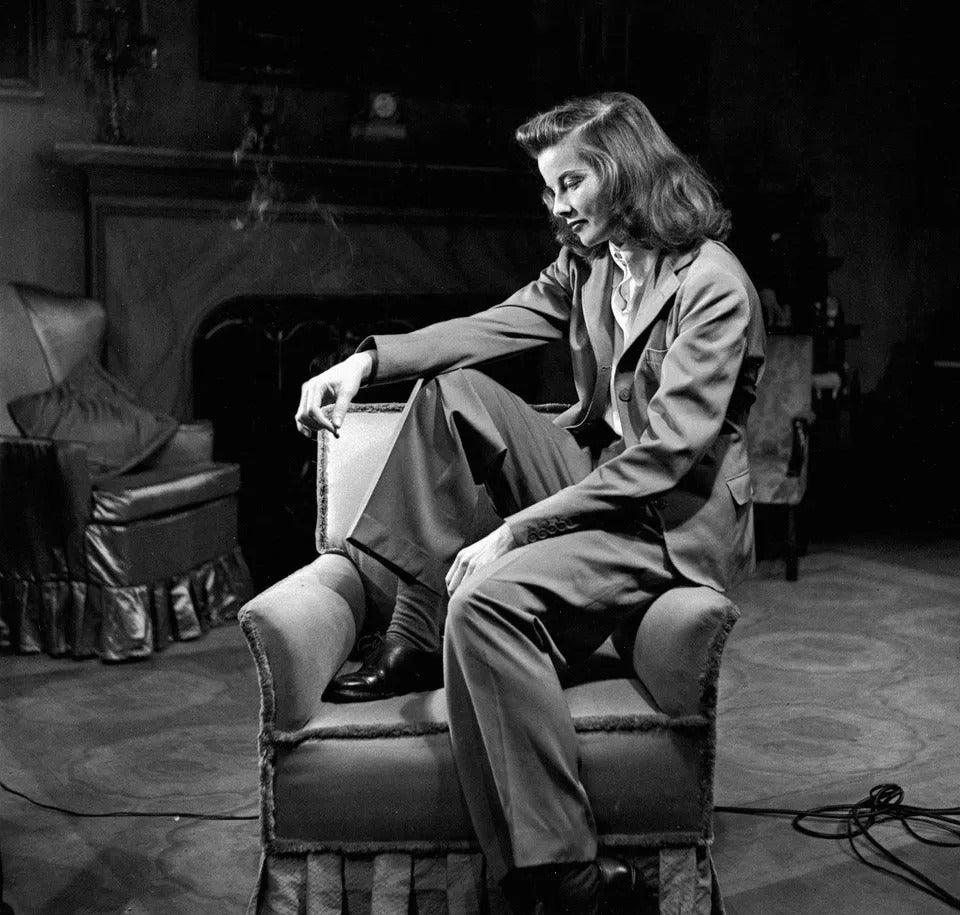The women's blazer originated in the early 20th century as a more formal and structured alternative to women's jackets. It was first popularized by women in the military and then adopted for use in the business world as a symbol of power and professionalism. Over the years, the blazer has evolved and been reinterpreted in different styles, fabrics, and colors, becoming a versatile piece in women's fashion. Today, the women's blazer is widely used for both casual and formal occasions, and is seen as a timeless classic in the world of women's clothing.

Katherine Hepburn by Alfred Eisenstaedt, 1938, The LIFE Picture Collection
A blazer is now a popular item for layering in women's fashion. It has become a staple in many women's wardrobes, but this hasn't always been the case. Women's history with blazers is relatively short compared to men's, but it reveals significant insights into the social and political experiences of women throughout the decades, and highlights the significance of fashion in our constantly evolving culture. Let's briefly examine the origin of the modern women's blazer and how it has transformed into a common item in our closets today.
Before World War II, wearing a blazer as a woman was considered "cross-dressing" by most of Western society. German actress and singer Marlene Dietrich was considered a rebel for her suits and men's tailoring. One famous example was her trip to Paris in 1933, where she wore a white suit and was threatened with arrest by the police chief for "impersonating a man," as it was illegal for women to wear pants in Paris until 2013. The women's blazer as we know it today was rare, except in certain upper-class circles and among a few bold Hollywood celebrities like Dietrich and Katherine Hepburn. Everything changed in the 1940s.

When World War II broke out in 1939, women were drafted into the workforce in a way that had never happened before. Their fashion quickly reflected this change, as we started to see women wearing adapted versions of masculine clothing, most notably the structured blazer. With sharp shoulders and bold lines, the contemporary blazer symbolized women breaking away from the more modest silhouettes they had previously been confined to. The elegant tailoring of this era combined with the practical military style still influences women's fashion today.
In the 1950s, society was trying to rebuild after the devastation of World War II and there was pressure for women to return to traditional gender roles to establish the ideal "nuclear family." Women's clothing quickly became more feminized, with boxy cuts and liberating fits being replaced by a more hourglass silhouette that complemented the full skirts and fitted dresses of the decade. This style, known as "the new look" by Christian Dior, offered a new take on blazers and evening jackets with impeccably tailored fits and nipped-in waists, but also symbolized a return to domesticity for women of the time. Over time, these silhouettes became softer and by the early 1960s, more relaxed tailoring had returned in line with second-wave feminism, as exemplified by Jackie Kennedy's Chanel coordinating suits.

On Marlene Dietrich’s trip to Paris in 1933, where she wore a white suit and was threatened with arrest by the police chief for "impersonating a man," as it was illegal for women to wear pants in Paris until 2013.
The feminist movement gained momentum in the 1970s, and as more women entered the workforce, the women's suit made a comeback. Despite criticism, career women embraced new versions of the classic pantsuit with exaggerated collars, belted waists, and bold colors, prints, and materials that remain popular today.

In the 1980s, "Power Dressing" became popular and when it came to blazers, bigger was better. Similar to World War II, women adapted masculine suits and silhouettes to assert dominance in the workplace. Pioneered by female icons such as Grace Jones, Princess Diana, Madonna, and others, the trend of oversized blazers continued throughout the 1990s and has remained in fashion ever since.
Nowadays, blazers are a staple in a modern woman's wardrobe, paired with a variety of outfits from jeans and crop tops to matching pants. Having reflected women's changing roles in society for years, it's important to reflect on the history of this iconic garment. Blazers have finally secured a permanent place in contemporary women's fashion and are likely to remain popular for many more years to come.
Let's take a look at the modern and feminine blazer jackets from Tracy Studio.









